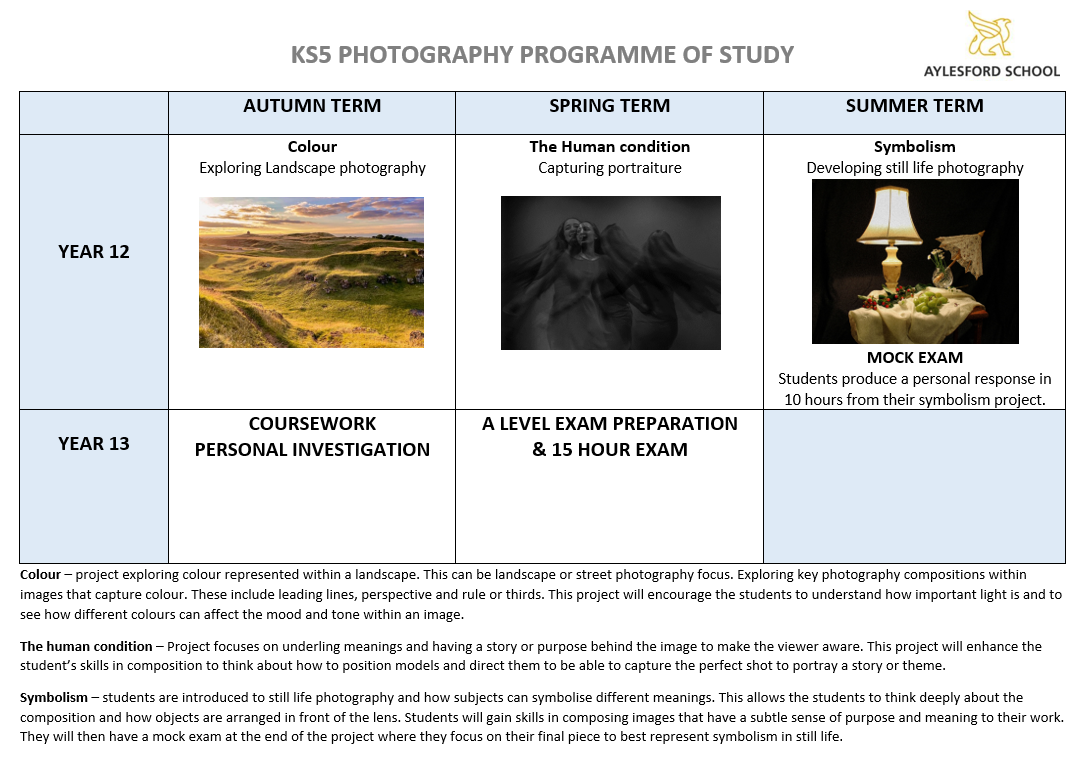| Key Topic: |
Colour |
The Human Condition |
Symbolism in Still Life |
| New Knowledge: |
Students are shown and taught how to develop a project from concept to final outcome.
Understand and analyse the work of a range of photographers; their purpose, and techniques.
Creating a creative response to colour within landscapes.
|
Students are encouraged to continue to develop an independent project showing thorough connections and explorations of the theme.
Students will start to develop deeper meanings into their projects linking to social and moral issues.
Understand and analyse the work of a range of photographers; their purpose, and techniques
|
Students are encouraged to develop an independent and individual projects.
Students are encouraged to develop an independent and individual project that will lead to the mock exam.
Students work in exam conditions for 10 hours to produce a final outcome inspired by a photographer of their choice. Reflection on marks for mock exam prior to starting the self-directed project.
To experiment with emotion and colour symbolism.
|
| Previous Knowledge Required: |
- Brainstorm ideas visually
- To make decisions about a suitable photographer to influence their design and gain an understanding of that photographers purpose, techniques and symbolism.
- Experiment with a range of different camera and editing techniques.
- To experiment with composition, space and lighting.
- Develop the ability to make decisions and work through refining and modifying ideas/ processes independently to create personal and meaningful responses that realise students’ intentions.
|
- Experiment with a range of different camera and editing techniques.
- Understand and analyse the work of a range of photographers; their purpose, techniques and symbolism.
- Directing model how to pose to create certain emotions/atmosphere within an image.
- Studio lighting and the importance of lighting.
|
- Experiment with a range of different camera and editing techniques.
- Understand and analyse the work of a range of artists; their purpose, techniques and symbolism.
|
| New Skills: |
- Taking a creative approach to the theme.
- Learning how to lay out a sketchbook.
- Developing their analysis skills
- Students shown how to develop an independent project and the processes to achieve a successful narrative through a guided process.
- Creating a unique final piece inspired by a photographer of their choice.
|
- Developing their sketchbook skills
- Thinking deeply about their responses and what they are portraying within their photographs.
|
- Developing final piece expectations
- Symbolism within still life
- Studio set up for still life
|
| Links to the School Curriculum: |
- Art – analysing
- Textiles – analysing
|
- Art – analysing
- Textiles – analysing
- Ethics – body image
- Media – body image and analysis.
|
- Food technology – fruit and vegetables symbolism
- Art – paintings
|
| Independent Activities: |
- Visit photography galleries, events and exhibitions to see photography first hand and make connections with your own work. Evidence this in your sketchbook.
- Those who are aiming for the highest grades need to work independently to produce more than the minimum amount of work which is that set by the class teacher.
- They should complete more pieces of recording; more development pieces; more pieces of refinement and use more photographer links as their work develops.
- They need to show a greater level of independence and a greater depth of contextual understanding in their artist links.
|
- Visit photography galleries, events and exhibitions to see photography first hand and make connections with your own work. Evidence this in your sketchbook.
- Those who are aiming for the highest grades need to work independently to produce more than the minimum amount of work which is that set by the class teacher.
- They should complete more pieces of recording; more development pieces; more pieces of refinement and use more photographer links as their work develops.
- They need to show a greater level of independence and a greater depth of contextual understanding in their artist links.
|
- Those who are aiming for the highest grades need to work independently to produce more than the minimum amount of work which is that set by the class teacher.
- They should complete more pieces of recording; more development pieces; more pieces of refinement and use more photographer links as their work develops.
- They need to show a greater level of independence and a greater depth of contextual understanding in their artist links.
- Visit photography galleries, events and exhibitions to see photography first hand and make connections with your own work. Evidence this in your sketchbook.
|
| Web Links: |
https://www.ocr.org.uk/qualifications/as-and-a-level/art-and-design-h200-h600-from-2015/ |
|
|


